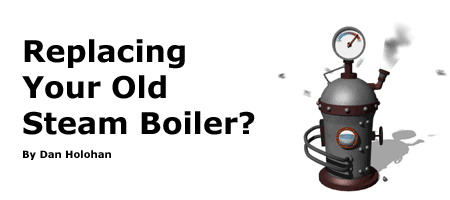If your steam boiler leaks, or if you realize the old unit has the efficiency of a campfire, you’re probably going to find yourself interviewing heating contractors. Only the bravest do-it-yourselfer will tackle an old steam system. As you negotiate with your contractor make sure you do these things:
Walk them through your home and discuss your comfort concerns. If it’s too hot in this room and too cold in that, let the contractor know. If there are gurgling or banging noises in the pipes or radiators, mention them, and ask the contractor to suggest a remedy.
Don’t expect a new boiler to magically solve your system-related problems. Explain to the contractor that you’re buying comfort, not just a new boiler, and that you expect the entire system – boiler, pipes and radiators – to work properly when the job is done.
At this point, a good heating contractor will most likely explain your options. Don’t be surprised if those options add to the cost of the job. Many steam systems suffer from ailments that have nothing to do with the boiler. When the contractor suggests these changes, ask if he will guarantee results. A good heating contractor will. If he’s not willing to stand behind his work, there’s a good chance he doesn’t know what he’s doing. Call someone else.
Don’t let the contractor base the size of your new boiler on the size of your old boiler. He must measure your radiators and analyze their ability to condense steam. If he bases the size of your new boiler solely on the size of your present boiler, he’s discounting the possibility that something may have changed during the past 60 or 70 years. He’s also acknowledging that the original installer was infallible. (Chances are, that guy wasn’t!)
If the contractor says, “Well, the old one worked well for years so let’s use the same size,” know that this guy is not someone who pays attention to details. Show him to the door.
Also, don’t let the contractor base the size of your new boiler on a heat-loss calculation of your home. Believe it or not, heat loss calculations mean absolutely nothing when it comes time to replace an old steam boiler. These calculations mean a lot when you’re sizing the steam radiators, but you’re not replacing the radiators, are you?
Consider this. Steam is a gas that will eagerly condense on cold metal. The boiler must be able to make enough steam to reach the furthest radiator before all the steam turns to water. In other words, the boiler’s ability to produce steam must match the system’s ability to condense steam. If the boiler is too small, parts of your home will always be cold. You’ll burn lots of fuel. If the boiler is too large, the burner will short-cycle, run inefficiently and the burner parts and controls will wear out long before their time.
If the contractor doesn’t take the time to survey and carefully measure your pipes and radiation, he doesn’t understand steam heating. Tell him to have a nice day, and then throw him out.
The piping around a modern steam boiler is crucial to the production of “dry” steam (steam that contains no more than 2% water). If the steam is wet, it will condense before it reaches all of your radiators. You’ll wind up with high fuel bills and uncomfortable rooms.
Nowadays, most reputable steam boiler manufacturers consider the piping immediately around the boiler to be a part of the boiler. They publish installation booklets showing the contractors how they must install their boilers. If a contractor doesn’t follow the manufacturer’s instructions, the boiler won’t operate efficiently, and there’s a good chance the manufacturer won’t honor their warranty should you have a problem.
So, insist on seeing the installation-and-operating manual beforehand. Have the contractor show you the correct near-boiler piping for the unit. And have him include in his contract a clause saying that he will install the boiler in full accordance with those instructions. This alone will scare away heating contractors who don’t know what they’re doing when it comes to old steam systems. Good riddance to those guys!
Don’t accept copper tubing for the boiler’s supply piping. Copper expands and contracts much more than steel. Because steam piping can take some odd angles, the expansion of the copper often puts a lot of torque on the soldered joints. That twisting action frequently causes the joints to come undone after a few years. And then you’re on your own.
Proper steam piping calls for threaded steel pipe and fittings. The threads allow the steel pipe to twist without coming apart. Copper tubing is the province of the low bidder. If you’re planning to stay a while in your old house, insist on properly installed, threaded steel pipe.
Modern high-efficiency boilers sometimes don’t get along well with old chimneys. Make sure you ask every heating contractor who steps into your home about your chimney. This is for your safety and protection.
An old chimney may need to be lined with stainless steel to keep the flue gases from condensing inside the chimney. Condensing gases form an acid that can eat through the mortar and cause parts of your chimney to fall apart. This, of course, leads to poor venting and potentially dangerous levels of carbon monoxide in your home. Carbon monoxide is deadly. If the contractor won’t talk about your chimney – if all he cares about is the boiler sale – he is not a professional. Go no further with this person.
Steam pipes must be insulated to keep the steam from condensing before it reaches the radiators. In the old days, we used asbestos. Nowadays, we spend a lot of money removing the asbestos, and we rarely replace it. Most folks figure the heat isn’t “lost” because it’s still inside the house. But if the steam is condensing in your basement pipes, it won’t be condensing in your bedroom radiators on the second floor. You’ll be burning lots of fuel and you’ll be miserably cold.
If your steam supply pipes are uninsulated, have the contractor include a price for new insulation. Or insulate them yourself. You can work wonders with a few rolls of fiberglass insulation and some duct tape. It may not look pretty, but it works well.
Reputable boiler manufacturers include cleaning instructions in their installation-and-operating manuals. The contractor must follow these instructions if your new boiler is to make dry steam. Have the contractor show you these instructions, and have him write on the contract that he will follow them to the letter. Then make sure he does.
It takes nearly a full day to properly clean an old steam system. There is no chemical or magic potion I know of that can make decades worth of dirt vanish. Don’t accept shortcuts.
Have the contractor install a drain valve in the boiler’s mud leg. The mud leg is the drum at the very bottom of the boiler, the place where sediment will gather. If you don’t insist on this drain valve, you probably won’t get it. Most contractors will leave the drain valve out to save a few bucks, but without it, you won’t have a way to flush sediment from your boiler as the years go by. Dirty boilers have shorter life spans than clean boilers.
Get the contractor to inspect your air vents and replace them if necessary. You’ll find these air vents on your radiators (if you have a one-pipe steam system) and near the ends of your mains (on both one- and two-pipe steam system). Good air vents make a dramatic difference in system performance. Even a brand-new boiler will gobble fuel if the air vents are old and clogged.
Be prepared to pay extra for the vents. But take some comfort in knowing that this is one of the best investments you can make in your old steam system.
Heating contractors buy their equipment from plumbing and heating wholesalers who handle specific brands of boilers. Since the wholesaler extends credit to the contractor, the contractor will usually buy what the wholesaler stocks.
Because of this, you may find it difficult to get three or four competitive prices if you base the comparison on a particular boiler. You see, the contractors you speak to may buy from different wholesalers. If you ask for Brand A and the contractors’ wholesalers stock Brands B or C or D, each contractor will try to sway you to the brand he’s used to installing. Rather than try to level the playing field by having them all quote on a certain boiler, do this: Let each contractor quote on what he thinks will best heat your home, but have each contractor guarantee the results in writing. Have them say, for instance, that when they’re finished, your house will heat comfortably, evenly and with no noise or squirting air vents. Some contractors will run for the hills when they realize you’re buying results instead of just a boiler, but you’re better off without those guys anyway.
A good contractor will talk to you seriously about your system’s problems and their solution. He’ll most likely suggest things that go beyond a simple boiler replacement. There are people out there who have no problem guaranteeing results.
A final note. Competent steam contractors generally charge more for a boiler replacement than others, but these guys deliver those wonderful results – increased comfort and substantial fuel savings.
They’ll never be the low-bidder, but they’re well worth their price.
And please remember that to be proficient at steam heating, a contractor doesn’t have to be 70 or 80 years old. He just has to be someone who’s done his homework well, and who knows how to listen well to your concerns about comfort in your old house.
Dan Holohan



Home › Forums › Replacing Your Old Steam Boiler?